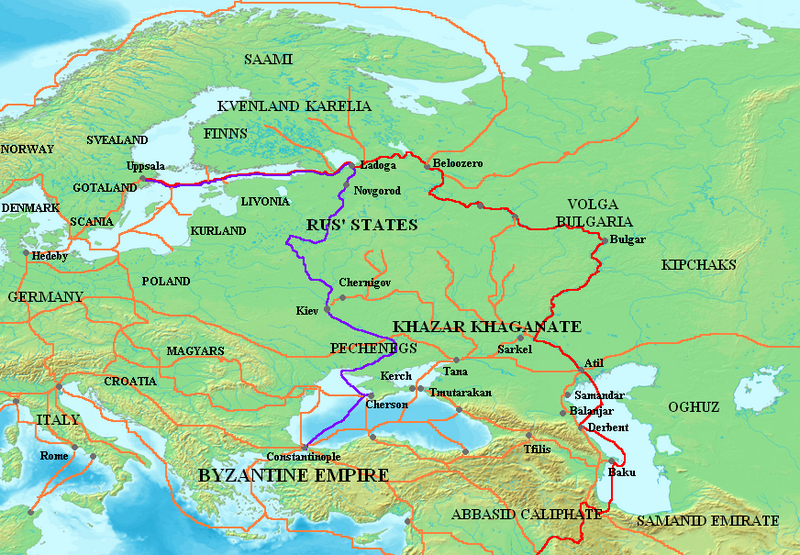Fil:Varangian routes.png

Storlek på förhandsvisningen: 800 × 555 pixlar. Andra upplösningar: 320 × 222 pixlar | 640 × 444 pixlar | 872 × 605 pixlar.
Originalfil (872 × 605 pixlar, filstorlek: 859 kbyte, MIME-typ: image/png)
Filhistorik
Klicka på ett datum/klockslag för att se filen som den såg ut då.
| Datum/Tid | Miniatyrbild | Dimensioner | Användare | Kommentar | |
|---|---|---|---|---|---|
| nuvarande | 3 oktober 2023 kl. 13.29 |  | 872 × 605 (859 kbyte) | OrionNimrod | Restore original: "Wallachians" added by Romanian user, however it was no Wallachia in the 8-11th c: British historian, Martyn Rady - Nobility, land and service in medieval Hungary (p91–93): the sources before the 13th century do not contain references to Vlachs anywhere in Hungary and Transylvania or in Wallachia. Byzantine sources mentioned Vlachs all deep in the Balcan. Also map should make by academic historians not by personal POV. |
| 16 augusti 2023 kl. 20.23 |  | 872 × 605 (799 kbyte) | Claude Zygiel | In one hand there are Byzantine sources which mention the Vlachs, secondly it is not because other sources do not mention them that they did not exist. In the other hand, the Hungarian theory which affirms that "the absence of proof is proof of absence", that this group disappeared for a thousand years, and that it would have been the only one, among all the peoples of the region , to not being able to cross the Balkans, the Danube and the Carpathians (while they were nomadic shepherds), is u... | |
| 25 juli 2023 kl. 12.54 |  | 872 × 605 (794 kbyte) | OrionNimrod | "Wallachians" added by Romanian user, however it was no Wallachia in the 8-11th c: British historian, Martyn Rady - Nobility, land and service in medieval Hungary (p91–93): the sources before the 13th century do not contain references to Vlachs anywhere in Hungary and Transylvania or in Wallachia | |
| 26 juni 2023 kl. 09.29 |  | 872 × 605 (799 kbyte) | Johannnes89 | Reverted to version as of 16:47, 18 April 2023 (UTC) crosswiki image spam, often containing historical inaccuracies | |
| 26 juni 2023 kl. 01.53 |  | 872 × 605 (1 017 kbyte) | Valdazleifr | Fixed minor errors | |
| 18 april 2023 kl. 18.47 |  | 872 × 605 (799 kbyte) | Claude Zygiel | There was no Wallachia but Wallachians. The theory that speakers of Eastern Romance languages disappeared for a thousand years between 275 and 1300 is only supported by Hungarian nationalist authors. | |
| 25 november 2022 kl. 14.41 |  | 872 × 605 (794 kbyte) | OrionNimrod | Reverted to version as of 15:59, 8 March 2009 (UTC) It was no Wallachia in the 8-11th century | |
| 21 maj 2015 kl. 14.44 |  | 872 × 605 (799 kbyte) | Spiridon Ion Cepleanu | Dvina & Wisla-Dnestr route, some details | |
| 8 mars 2009 kl. 17.59 |  | 872 × 605 (794 kbyte) | Mahahahaneapneap | Compressed | |
| 19 januari 2007 kl. 01.15 |  | 872 × 605 (859 kbyte) | Electionworld | {{ew|en|Briangotts}} == Summary == Map showing the major Varangian trade routes, the Volga trade route (in red) and the Trade Route from the Varangians to the Greeks (in purple). Other trade routes of the 8th-11th centuries shown in orange |
Filanvändning
Följande 4 sidor använder den här filen:
Global filanvändning
Följande andra wikier använder denna fil:
- Användande på af.wikipedia.org
- Användande på ar.wikipedia.org
- Användande på ast.wikipedia.org
- Användande på az.wikipedia.org
- Användande på be-tarask.wikipedia.org
- Användande på be.wikipedia.org
- Användande på bg.wikipedia.org
- Användande på ca.wikipedia.org
- Användande på ckb.wikipedia.org
- Användande på cs.wikipedia.org
- Användande på cv.wikipedia.org
- Användande på cy.wikipedia.org
- Användande på de.wikipedia.org
- Användande på el.wikipedia.org
- Användande på en.wikipedia.org
Visa mer globalt användande av denna fil.


